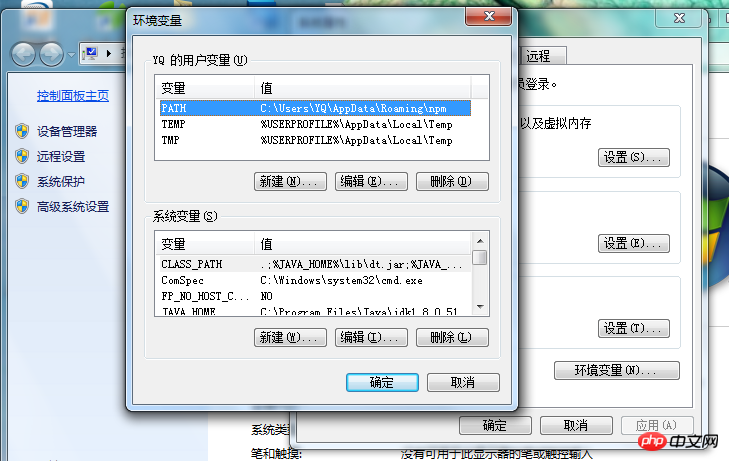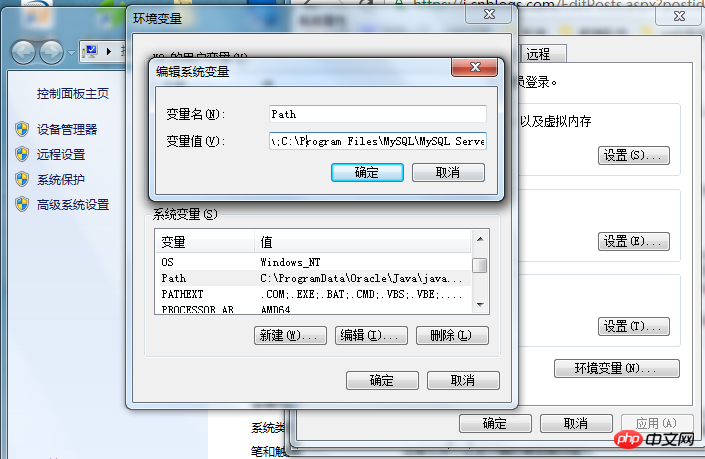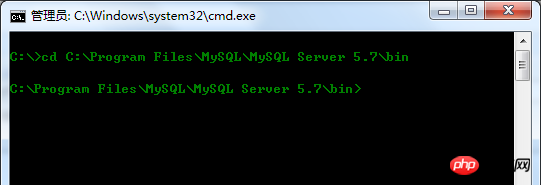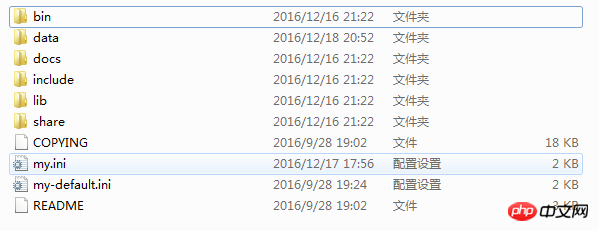Tutorial on installing mysql5.7 under windows (picture and text)
This article mainly introduces mysql5.7 installation tutorial under windows in detail, which has certain reference value. Interested friends can refer to it
mysql5.7 Installation and configuration methods, compiled and shared with everyone
Download
##Installation
Double-click mysql.msi and follow the prompts to install.Issues that need attention after installation (Key points)
Set the mysql environment environment variable (just let mysql be in any path in cmd Called)1. Right-click the computer and click Properties
System Variables Settings and click Environment Variables



Initialize mysql
1. After entering mysql5.7 installation The root path (the default installation path is C:\Program Files\MySQL\MySQL Server 5.7, if you have changed it during installation, it will be your changed path), which will be referred to as the root directory later 2, mysql rootDirectory structure is as follows


to open the my.ini file, add "skip_grant_tables" at the end of the file content, and save the file. 5. Use cmd to enter the bin folder of the root directory.
Press the Windows Home key (the key to the left of the alt key in the lower left corner of the keyboard, shaped like "field") + R. After entering cmd, Press the Enter key
 Input "cd C:\Program Files\MySQL\MySQL Server 5.7**bin**" in the pop-up window and press Enter
Input "cd C:\Program Files\MySQL\MySQL Server 5.7**bin**" in the pop-up window and press Enter
 Enter "mysqld --initialize" and press Enter. The data folder will be generated in the root directory. At this time, mysql initialization is completed. The root directory structure after initialization is completed is as shown below
Enter "mysqld --initialize" and press Enter. The data folder will be generated in the root directory. At this time, mysql initialization is completed. The root directory structure after initialization is completed is as shown below

1. Press the Windows Home key + R (the key to the left of the alt key in the lower left corner of the keyboard, shaped like "Tian" ), after entering cmd, press the Enter key
 2. In the pop-up window, enter "cd C:\Program Files\MySQL\MySQL Server 5.7**bin** "Press Enter
2. In the pop-up window, enter "cd C:\Program Files\MySQL\MySQL Server 5.7**bin** "Press Enter
 3. Enter "mysqld --install" and press Enter, as shown below (I have registered the service before, so it will prompt that the service has been completed)
3. Enter "mysqld --install" and press Enter, as shown below (I have registered the service before, so it will prompt that the service has been completed)
 4. Now you can use "net start mysql" in cmd to start the mysql service, and use "net stop mysql" to stop the service. (Need to set the mysql environment variable)
4. Now you can use "net start mysql" in cmd to start the mysql service, and use "net stop mysql" to stop the service. (Need to set the mysql environment variable)

1. My.ini file in the root directory Add "skip_grant_table" at the end, save and exit (it has been done before, you can skip it).
2. Open cmd and enter the following commands in sequence, and press Enter (when prompted to enter a password, just press Enter)
mysql -u root -p;
use mysql;
update user set authentication_string=password("123456") where user="root";
flush privileges;
update user set password_expired="N" where user="root";3. Delete the "skip_grant_table" added at the end of the my.ini file in the root directory, save and exit, restart mysql, and you can log in with the new password.
Perform the above steps in sequence, and mysql-5.7 can be successfully installed.
Wonderful topic sharing:
Steps to install MySQL5.7 under CentOS7 (pictures and texts)
##Tutorial on installing MySQL-5.7 under Linux ( Pictures and text)
The above is the detailed content of Tutorial on installing mysql5.7 under windows (picture and text). For more information, please follow other related articles on the PHP Chinese website!

Hot AI Tools

Undresser.AI Undress
AI-powered app for creating realistic nude photos

AI Clothes Remover
Online AI tool for removing clothes from photos.

Undress AI Tool
Undress images for free

Clothoff.io
AI clothes remover

AI Hentai Generator
Generate AI Hentai for free.

Hot Article

Hot Tools

Notepad++7.3.1
Easy-to-use and free code editor

SublimeText3 Chinese version
Chinese version, very easy to use

Zend Studio 13.0.1
Powerful PHP integrated development environment

Dreamweaver CS6
Visual web development tools

SublimeText3 Mac version
God-level code editing software (SublimeText3)

Hot Topics
 1378
1378
 52
52
 Can I install mysql on Windows 7
Apr 08, 2025 pm 03:21 PM
Can I install mysql on Windows 7
Apr 08, 2025 pm 03:21 PM
Yes, MySQL can be installed on Windows 7, and although Microsoft has stopped supporting Windows 7, MySQL is still compatible with it. However, the following points should be noted during the installation process: Download the MySQL installer for Windows. Select the appropriate version of MySQL (community or enterprise). Select the appropriate installation directory and character set during the installation process. Set the root user password and keep it properly. Connect to the database for testing. Note the compatibility and security issues on Windows 7, and it is recommended to upgrade to a supported operating system.
 How to speed up the loading speed of PS?
Apr 06, 2025 pm 06:27 PM
How to speed up the loading speed of PS?
Apr 06, 2025 pm 06:27 PM
Solving the problem of slow Photoshop startup requires a multi-pronged approach, including: upgrading hardware (memory, solid-state drive, CPU); uninstalling outdated or incompatible plug-ins; cleaning up system garbage and excessive background programs regularly; closing irrelevant programs with caution; avoiding opening a large number of files during startup.
 In front-end development, how to use CSS and JavaScript to achieve searchlight effects similar to Windows 10 settings interface?
Apr 05, 2025 pm 10:21 PM
In front-end development, how to use CSS and JavaScript to achieve searchlight effects similar to Windows 10 settings interface?
Apr 05, 2025 pm 10:21 PM
How to implement Windows-like in front-end development...
 How to distinguish between closing a browser tab and closing the entire browser using JavaScript?
Apr 04, 2025 pm 10:21 PM
How to distinguish between closing a browser tab and closing the entire browser using JavaScript?
Apr 04, 2025 pm 10:21 PM
How to distinguish between closing tabs and closing entire browser using JavaScript on your browser? During the daily use of the browser, users may...
 How to pull the vertical reference line of PS
Apr 06, 2025 pm 08:18 PM
How to pull the vertical reference line of PS
Apr 06, 2025 pm 08:18 PM
Pull vertical guides in Photoshop: Enable ruler view (View > ruler). Hover the mouse over the vertical edge of the ruler, and then the cursor becomes a vertical line with double arrows and hold and drag the mouse to pull out the reference line. Click Delete by dragging the guide, or hovering it into a cross.
 Solutions to the errors reported by MySQL on a specific system version
Apr 08, 2025 am 11:54 AM
Solutions to the errors reported by MySQL on a specific system version
Apr 08, 2025 am 11:54 AM
The solution to MySQL installation error is: 1. Carefully check the system environment to ensure that the MySQL dependency library requirements are met. Different operating systems and version requirements are different; 2. Carefully read the error message and take corresponding measures according to prompts (such as missing library files or insufficient permissions), such as installing dependencies or using sudo commands; 3. If necessary, try to install the source code and carefully check the compilation log, but this requires a certain amount of Linux knowledge and experience. The key to ultimately solving the problem is to carefully check the system environment and error information, and refer to the official documents.
 MySQL can't be installed after downloading
Apr 08, 2025 am 11:24 AM
MySQL can't be installed after downloading
Apr 08, 2025 am 11:24 AM
The main reasons for MySQL installation failure are: 1. Permission issues, you need to run as an administrator or use the sudo command; 2. Dependencies are missing, and you need to install relevant development packages; 3. Port conflicts, you need to close the program that occupies port 3306 or modify the configuration file; 4. The installation package is corrupt, you need to download and verify the integrity; 5. The environment variable is incorrectly configured, and the environment variables must be correctly configured according to the operating system. Solve these problems and carefully check each step to successfully install MySQL.
 Unable to access mysql from terminal
Apr 08, 2025 pm 04:57 PM
Unable to access mysql from terminal
Apr 08, 2025 pm 04:57 PM
Unable to access MySQL from the terminal may be due to: MySQL service not running; connection command error; insufficient permissions; firewall blocks connection; MySQL configuration file error.




